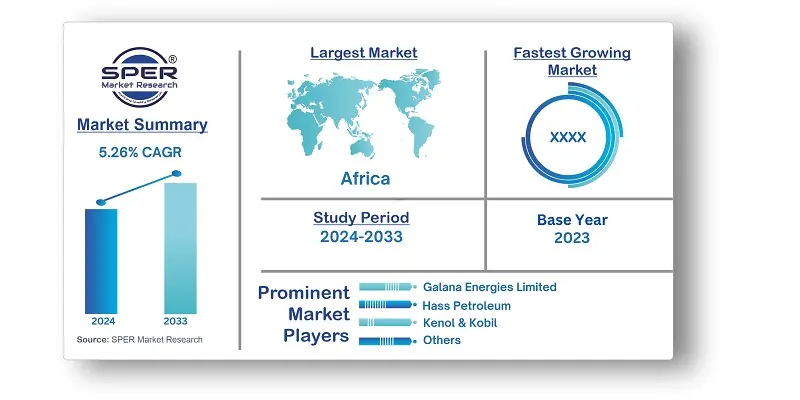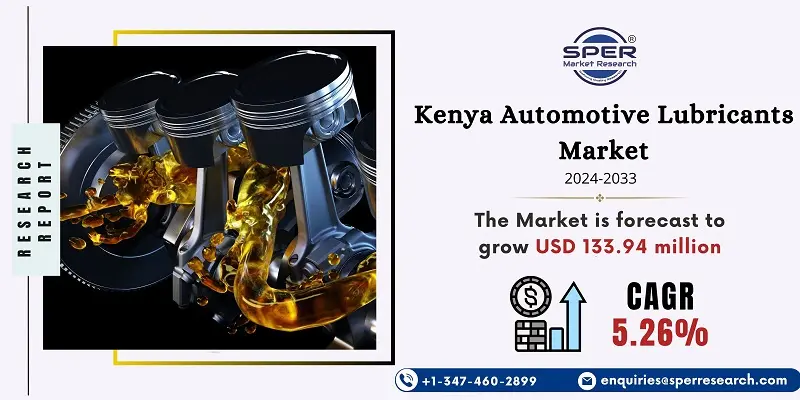
Kenya Automotive Lubricants Market Growth, Size, Trends, Demand, Revenue and Future Outlook
Kenya Automotive Lubricants Market Size- By Product Type, By Vehicle Type, By Composition, By Sales Channel- Regional Outlook, Competitive Strategies and Segment Forecast to 2033
| Published: Jun-2024 | Report ID: AMIN24150 | Pages: 1 - 103 | Formats*: |
| Category : Automotive & Transportation | |||
- The National Oil Corporation of Kenya (NOCK) and the Kenya Pipeline Company are two of the eleven state-owned Kenyan companies that the country's National Treasury announced plans to privatise in November 2023.
- May 2023: ONGC Videsh, India's main overseas oil firm, has found a new partner in Oil India Ltd. to replace a reluctant IndianOil (IOC) in the probable acquisition of a 50% share in Tullow Oil Plc's USD 3.4 billion oilfield project in Kenya. However, the OVL-OIL combination may face competition from Sinopec, which entered the fight to take advantage of India's delay in finalising the agreement.
- February 2023: Vivo Energy in Kenya agreed to buy a 74% stake in Engen Limited from PETRONAS International Corporation Ltd. in order to grow its market position, revenue, and lead competitors TotalEnergies and Rubis.


| Report Metric | Details |
| Market size available for years | 2020-2033 |
| Base year considered | 2023 |
| Forecast period | 2024-2033 |
| Segments covered | By Product Type, By Vehicle Type, By Composition, By Sales Channel |
| Regions covered | Eastern, Northern, Southern, Western |
| Companies Covered | Galana Energies Limited, Hass Petroleum, Kenol & Kobil, National Oil Corporation of Kenya, Energizing Kenya, OLA Energy, Oryx Energies, Sepyana Oil East Africa Ltd, Sinopec, TotalEnergies Marketing Kenya PLC, Vivo Energy (Shell). |
- Vehicle Owners
- Automotive Dealerships
- Independent Repair Shops and Garages
- Fleet Operators and Managers
- Public Transportation Operators
- Industrial and Construction Companies
- Agriculture Sector
- Government and Municipalities
- Automotive Parts Retailers
- Lubricant Distributors and Wholesalers
| By Product Type: | |
| By vehicle Type: | |
| By Composition: | |
| By Sales Channel: |
- Kenya Automotive Lubricants Market Size (FY’2024-FY’2033)
- Overview of Kenya Automotive Lubricants Market
- Segmentation of Kenya Automotive Lubricants Market by Product Type (Engine Oil, Transmission & Hydraulic Fluids, Gear Oil, Grease, Chain Oil, Brake Fluids, Others)
- Segmentation of Kenya Automotive Lubricants Market by Vehicle Type (ICE Vehicles EV)
- Segmentation of Kenya Automotive Lubricants Market by Composition (Mineral Oil Lubricants, Fully Synthetic Oil Lubricants, Semi-synthetic Lubricants)
- Segmentation of Kenya Automotive Lubricants Market by Sales Channel (Original Equipment Manufacturers (OEMs), Aftermarket)
- Statistical Snap of Kenya Automotive Lubricants Market
- Expansion Analysis of Kenya Automotive Lubricants Market
- Problems and Obstacles in Kenya Automotive Lubricants Market
- Competitive Landscape in the Kenya Automotive Lubricants Market
- Impact of COVID-19 and Demonetization on Kenya Automotive Lubricants Market
- Details on Current Investment in Kenya Automotive Lubricants Market
- Competitive Analysis of Kenya Automotive Lubricants Market
- Prominent Players in the Kenya Automotive Lubricants Market
- SWOT Analysis of Kenya Automotive Lubricants Market
- Kenya Automotive Lubricants Market Future Outlook and Projections (FY’2024-FY’2033)
- Recommendations from Analyst
1.1. Scope of the report1.2. Market segment analysis
2.1. Research data source
2.1.1. Secondary Data2.1.2. Primary Data2.1.3. SPER’s internal database2.1.4. Premium insight from KOL’s
2.2. Market size estimation
2.2.1. Top-down and Bottom-up approach
2.3. Data triangulation
4.1. Driver, Restraint, Opportunity and Challenges analysis
4.1.1. Drivers4.1.2. Restraints4.1.3. Opportunities4.1.4. Challenges
4.2. COVID-19 Impacts of the Kenya Automotive Lubricants Market.
5.1. SWOT Analysis
5.1.1. Strengths5.1.2. Weaknesses5.1.3. Opportunities5.1.4. Threats
5.2. PESTEL Analysis
5.2.1. Political Landscape5.2.2. Economic Landscape5.2.3. Social Landscape5.2.4. Technological Landscape5.2.5. Environmental Landscape5.2.6. Legal Landscape
5.3. PORTER’s Five Forces
5.3.1. Bargaining power of suppliers5.3.2. Bargaining power of buyers5.3.3. Threat of Substitute5.3.4. Threat of new entrant5.3.5. Competitive rivalry
5.4. Heat Map Analysis
6.1. Kenya Automotive Lubricants Market Manufacturing Base Distribution, Sales Area, Product Type6.2. Mergers & Acquisitions, Partnerships, Product Launch, and Collaboration in Kenya Automotive Lubricants Market
7.1. Kenya Automotive Lubricants Market Size, Share and Forecast, By Product Type, 2020-20267.2. Kenya Automotive Lubricants Market Size, Share and Forecast, By Product Type, 2027-20337.3. Engine Oil7.4. Transmission & Hydraulic Fluids7.5. Gear Oil7.6. Grease
7.6.1. Multipurpose Grease7.6.2. Automotive Grease7.6.3. Synthetic Grease
7.7. Chain Oil7.8. Brake Fluids7.9. Others
8.1. Kenya Automotive Lubricants Market Size, Share and Forecast, By Vehicle Type, 2020-20268.2. Kenya Automotive Lubricants Market Size, Share and Forecast, By Vehicle Type, 2027-20338.3. ICE Vehicles (Internal Combustion Engine)
8.3.1. Passenger Cars8.3.2. Light Commercial Vehicle8.3.3. Heavy Commercial Vehicle8.3.4. Two/Three Wheelers8.3.5. Agricultural Vehicles8.3.6. Special Purpose Vehicles
8.4. EV (Electric vehicles)
8.4.1. Passenger Cars8.4.2. Light Commercial Vehicle8.4.3. Heavy Commercial Vehicle8.4.4. Two/Three Wheelers8.4.5. Agricultural Vehicles8.4.6. Special Purpose Vehicles
9.1. Kenya Automotive Lubricants Market Size, Share and Forecast, By Composition, 2020-20269.2. Kenya Automotive Lubricants Market Size, Share and Forecast, By Composition, 2027-20339.3. Mineral Oil Lubricants
9.3.1. Paraffinic Oil9.3.2. Naphthenics Oil
9.4. Fully Synthetic Oil Lubricants
9.4.1. Polyalphaolefins9.4.2. Ester Oil
9.5. Semi-synthetic Lubricants
10.1. Kenya Automotive Lubricants Market Size, Share and Forecast, By Sales Channel, 2020-202610.2. Kenya Automotive Lubricants Market Size, Share and Forecast, By Sales Channel, 2027-203310.3. Original Equipment Manufacturers (OEMs)10.4. Aftermarket
11.1. Kenya Automotive Lubricants Market Size and Market Share
12.1. Kenya Automotive Lubricants Market Size and Market Share By Region (2020-2026)12.2. Kenya Automotive Lubricants Market Size and Market Share By Region (2027-2033)12.3. Eastern12.4. Northern12.5. Southern12.6. Western
13.1. Galana Energies Limited
13.1.1. Company details13.1.2. Financial outlook13.1.3. Product summary13.1.4. Recent developments
13.2. Hass Petroleum
13.2.1. Company details13.2.2. Financial outlook13.2.3. Product summary13.2.4. Recent developments
13.3. Kenol & Kobil
13.3.1. Company details13.3.2. Financial outlook13.3.3. Product summary13.3.4. Recent developments
13.4. National Oil Corporation of Kenya, Energizing Kenya
13.4.1. Company details13.4.2. Financial outlook13.4.3. Product summary13.4.4. Recent developments
13.5. OLA Energy
13.5.1. Company details13.5.2. Financial outlook13.5.3. Product summary13.5.4. Recent developments
13.6. Oryx Energies
13.6.1. Company details13.6.2. Financial outlook13.6.3. Product summary13.6.4. Recent developments
13.7. Sepyana Oil East Africa Ltd
13.7.1. Company details13.7.2. Financial outlook13.7.3. Product summary13.7.4. Recent developments
13.8. Sinopec
13.8.1. Company details13.8.2. Financial outlook13.8.3. Product summary13.8.4. Recent developments
13.9. TotalEnergies Marketing Kenya PLC
13.9.1. Company details13.9.2. Financial outlook13.9.3. Product summary13.9.4. Recent developments
13.10. Vivo Energy (Shell)
13.10.1. Company details13.10.2. Financial outlook13.10.3. Product summary13.10.4. Recent developments
13.11. Others
SPER Market Research’s methodology uses great emphasis on primary research to ensure that the market intelligence insights are up to date, reliable and accurate. Primary interviews are done with players involved in each phase of a supply chain to analyze the market forecasting. The secondary research method is used to help you fully understand how the future markets and the spending patterns look likes.
The report is based on in-depth qualitative and quantitative analysis of the Product Market. The quantitative analysis involves the application of various projection and sampling techniques. The qualitative analysis involves primary interviews, surveys, and vendor briefings. The data gathered as a result of these processes are validated through experts opinion. Our research methodology entails an ideal mixture of primary and secondary initiatives.



Frequently Asked Questions About This Report
PLACE AN ORDER
Year End Discount
Sample Report
Pre-Purchase Inquiry
NEED CUSTOMIZATION?
Request CustomizationCALL OR EMAIL US
100% Secure Payment






Related Reports
Our Global Clients
Our data-driven insights have influenced the strategy of 200+ reputed companies across the globe.




















